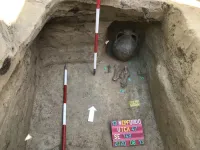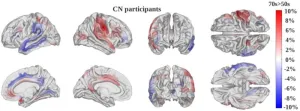(Press-News.org) Survey Finds Many Americans Greatly Overestimate Primary Care Spending
Background and Goal: This study, based on an online survey of 1,135 adults demographically representative of the U.S. population, aimed to measure public perceptions of primary care spending.
Key Insights: Respondents believed that 51.8% of overall health care spending goes to primary care—more than 10 times the documented share of 4.7%. Additionally, respondents believed that primary care addresses 58.7% of health care needs, very close to actual primary care utilization as a percentage of all ambulatory physician visits in the United States (50.3%).
Why It Matters: Chronic underinvestment in primary care has resulted in workforce shortages, physician burnout, reduced access, and suboptimal care. Access to high-quality primary care has been associated with better population health and more equitable outcomes.
The General Public Vastly Overestimates Primary Care Spending in the United States
Melissa Ma, BS, et al
School of Medicine, University of California, San Francisco, San Francisco, California
END
Survey finds many Americans greatly overestimate primary care spending
The general public vastly overestimates primary care spending in the united states
2025-02-24
ELSE PRESS RELEASES FROM THIS DATE:
Researchers advance RNA medical discovery decades ahead of schedule
2025-02-24
Ribonucleic acid, commonly known as RNA, is involved in many biological functions, and some, including gene silencing, are utilitized to cure diseases. RNA has recently gained attention as a promising drug target. Unfortunately, only a small fraction of RNA structures have been determined experimentally, and the process of uncovering these structures requires significant time and effort. Using this time scale, the structures of many life saving RNA may not be discovered for years. As a result, there is a significant gap between the types of known ...
Immune ‘fingerprints’ aid diagnosis of complex diseases in Stanford Medicine study
2025-02-24
Your immune system harbors a lifetime’s worth of information about threats it’s encountered — a biological Rolodex of baddies. Often the perpetrators are viruses and bacteria you’ve conquered; others are undercover agents like vaccines given to trigger protective immune responses or even red herrings in the form of healthy tissue caught in immunological crossfire.
Now researchers at Stanford Medicine have devised a way to mine this rich internal database to diagnose diseases as diverse as diabetes COVID-19 responses to influenza vaccines. Although they envision the approach as a way to screen for multiple diseases ...
Ancient beaches testify to long-ago ocean on Mars
2025-02-24
A Chinese rover that landed on Mars in 2021 detected evidence of underground beach deposits in an area thought to have once been the site of an ancient sea, providing further evidence that the planet long ago had a large ocean.
The now-inactive rover, called Zhurong, operated for a year, between May 2021 and May 2022. It traveled 1.9 kilometers (1.2 miles) roughly perpendicular to escarpments thought to be an ancient shoreline from a time — 4 billion years ago — when Mars had a thicker atmosphere and a warmer climate. Along its path, the rover used ground penetrating radar (GPR) to probe up to 80 meters (260 feet) beneath the surface. This ...
Gulf of Mars: Rover finds evidence of ‘vacation-style’ beaches on Mars
2025-02-24
UNIVERSITY PARK, Pa. — Mars may have once been home to sun-soaked, sandy beaches with gentle, lapping waves according to a new study published today (Feb. 24) in the Proceedings of the National Academy of Sciences (PNAS).
An international team of scientists, including Penn State researchers, used data from the Zhurong Mars rover to identify hidden layers of rock under the planet’s surface that strongly suggest the presence of an ancient northern ocean. The new research offers the clearest evidence yet that the planet ...
MSU researchers use open-access data to study climate change effects in 24,000 US lakes
2025-02-24
Feb. 24, 2025
MSU has a satellite uplink/LTN TV studio and Comrex line for radio interviews upon request.
Contact: Emilie Lorditch: 517-355-4082, lorditch@msu.edu
Images
MSU researchers use open-access data to study climate change effects in 24,000 US lakes
EAST LANSING, Mich. – Each summer, more and more lake beaches are forced to close due to toxic algae blooms. While climate change is often blamed, new research suggests a more complex story: climate interacts with human activities like agriculture and urban runoff, which funnel excess ...
More than meets the eye: An adrenal gland tumor is more complex than previously thought
2025-02-24
Fukuoka, Japan - Kyushu University researchers have uncovered a surprising layer of complexity in aldosterone-producing adenomas (APAs)—adrenal gland tumors that drive high blood pressure. Using cutting-edge analysis techniques, they discovered that these tumors harbor at least four distinct cell types, including ones that produce cortisol, the body’s main stress hormone. Published in the week beginning 24 February in PNAS, their findings not only explain why some patients with APAs develop unexpected health issues, like weakened bones, but also pave the way toward new treatment strategies.
“Currently, the only ...
Origin and diversity of Hun Empire populations
2025-02-24
The Huns suddenly appeared in Europe in the 370s, establishing one of the most influential although short-lived empires in Europe. Scholars have long debated whether the Huns were descended from the Xiongnu. In fact, the Xiongnu Empire dissolved around 100 CE, leaving a 300-year gap before the Huns appeared in Europe. Can DNA lineages that bridge these three centuries be found?
To address this question, researchers analyzed the DNA of 370 individuals that lived in historical periods spanning around 800 years, from 2nd century BCE to 6th century CE, encompassing sites in the Mongolian steppe, Central Asia, and the Carpathian Basin of Central Europe. ...
New AI model measures how fast the brain ages
2025-02-24
A new artificial intelligence model measures how fast a patient’s brain is aging and could be a powerful new tool for understanding, preventing and treating cognitive decline and dementia, according to USC researchers.
The first-of-its-kind tool can non-invasively track the pace of brain changes by analyzing magnetic resonance imaging (MRI) scans. Faster brain aging closely correlates with a higher risk of cognitive impairment, said Andrei Irimia, associate professor of gerontology, biomedical engineering, quantitative ...
This new treatment can adjust to Parkinson's symptoms in real time
2025-02-24
Starting today, people with Parkinson’s disease will have a new treatment option, thanks to U.S. Food and Drug Administration approval of groundbreaking new technology.
The therapy, known as adaptive deep brain stimulation, or aDBS, uses an implanted device that continuously monitors the brain for signs that Parkinson’s symptoms are developing. When it detects specific patterns of brain activity, it delivers precisely calibrated electric pulses to keep symptoms at bay.
The FDA approval covers two treatment algorithms that run on a device made by Medtronic, a medical device company. Both work by monitoring the same part of the brain, called the subthalamic nucleus. ...
Bigger animals get more cancer, defying decades-old belief
2025-02-24
Elephants, giraffes, pythons and other large species have higher cancer rates than smaller ones like mice, bats, and frogs, a new study has shown, overturning a 45-year-old belief about cancer in the animal kingdom.
The research, conducted by researchers from the University of Reading, University College London and The Johns Hopkins University School of Medicine, examined cancer data from 263 species across four major animal groups - amphibians, birds, mammals and reptiles. The findings challenge "Peto's paradox," a longstanding idea based on observations from 1977 that suggested ...
LAST 30 PRESS RELEASES:
New study shows how the spleen helps the immune system accept a transplant
New Mayo Clinic study advances personalized prostate cancer education with an EHR-integrated AI agent
Researchers identify novel therapeutic target to improve recovery after nerve injury
Microbes in breast milk help populate infant gut microbiomes
Reprogramming immunity to rewrite the story of Type 1 diabetes
New tool narrows the search for ideal material structures
Artificial saliva containing sugarcane protein helps protect the teeth of patients with head and neck cancer
Understanding the role of linear ubiquitination in T-tubule biogenesis
Researchers identify urban atmosphere as primary reservoir of microplastics
World’s oldest arrow poison – 60,000-year-old traces reveal early advanced hunting techniques
Bristol scientists discover early sponges were soft
New study uncovers how rice viruses manipulate plant defenses to protect insect vectors
NSF–DOE Vera C. Rubin Observatory spots record-breaking asteroid in pre-survey observations
Ribosomal engineering creates “super-probiotic” bacteria
This self-powered eye tracker harnesses energy from blinking and is as comfortable as everyday glasses
Adverse prenatal exposures linked to higher rates of mental health issues, brain changes in adolescents
Restoring mitochondria shows promise for treating chronic nerve pain
Nature study identifies a molecular switch that controls transitions between single-celled and multicellular forms
USU chemists' CRISPR discovery could lead to single diagnostic test for COVID, flu, RSV
Early hominins from Morocco reveal an African lineage near the root of Homo sapiens
Small chimps, big risks: What chimps show us about our own behavior
We finally know how the most common types of planets are created
Thirty-year risk of cardiovascular disease among healthy women according to clinical thresholds of lipoprotein(a)
Yoga for opioid withdrawal and autonomic regulation
Gene therapy ‘switch’ may offer non-addictive pain relief
Study shows your genes determine how fast your DNA mutates with age
Common brain parasite can infect your immune cells. Here's why that's probably OK
International experts connect infections and aging through cellular senescence
An AI–DFT integrated framework accelerates materials discovery and design
Twist to reshape, shift to transform: Bilayer structure enables multifunctional imaging
[Press-News.org] Survey finds many Americans greatly overestimate primary care spendingThe general public vastly overestimates primary care spending in the united states



